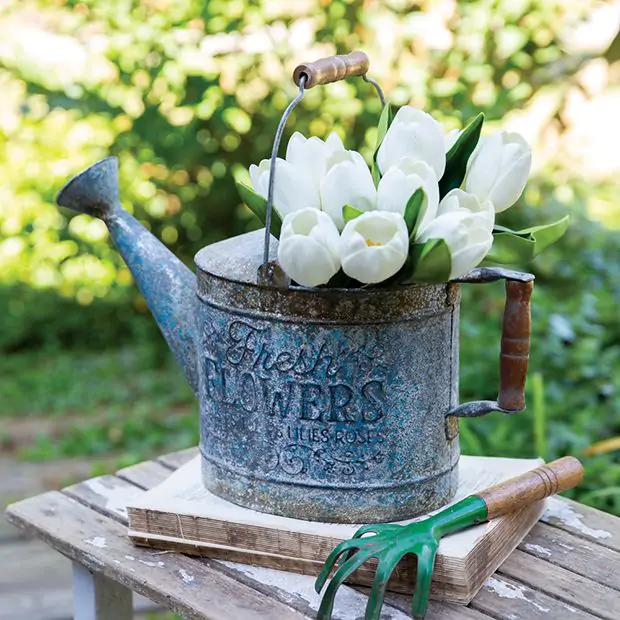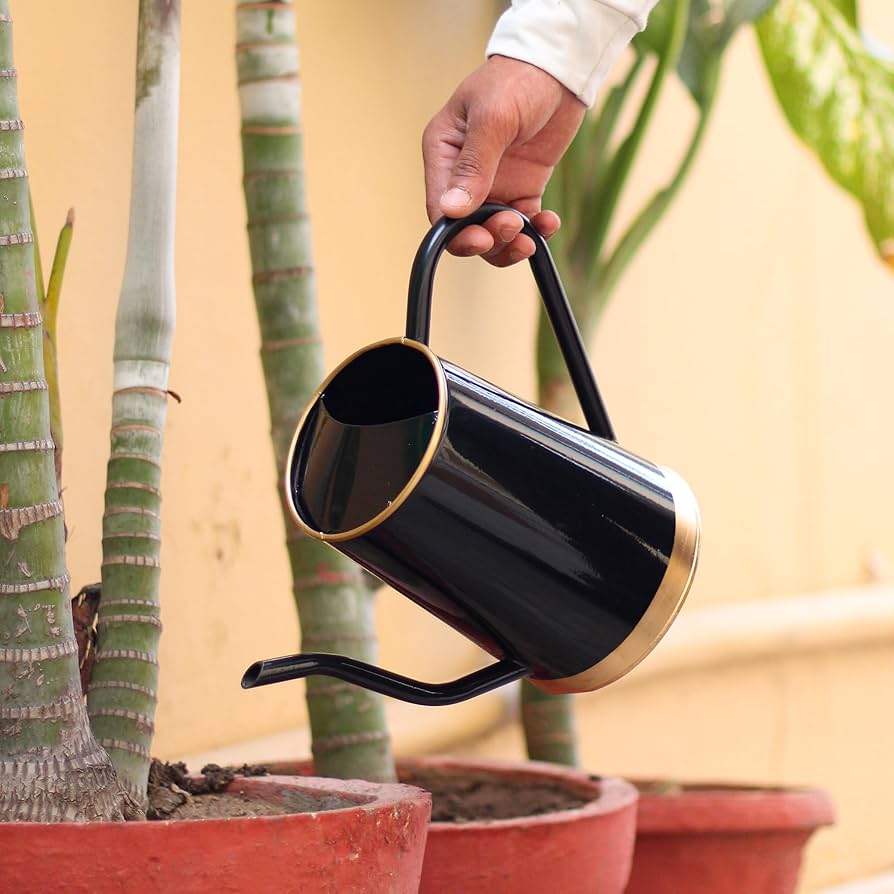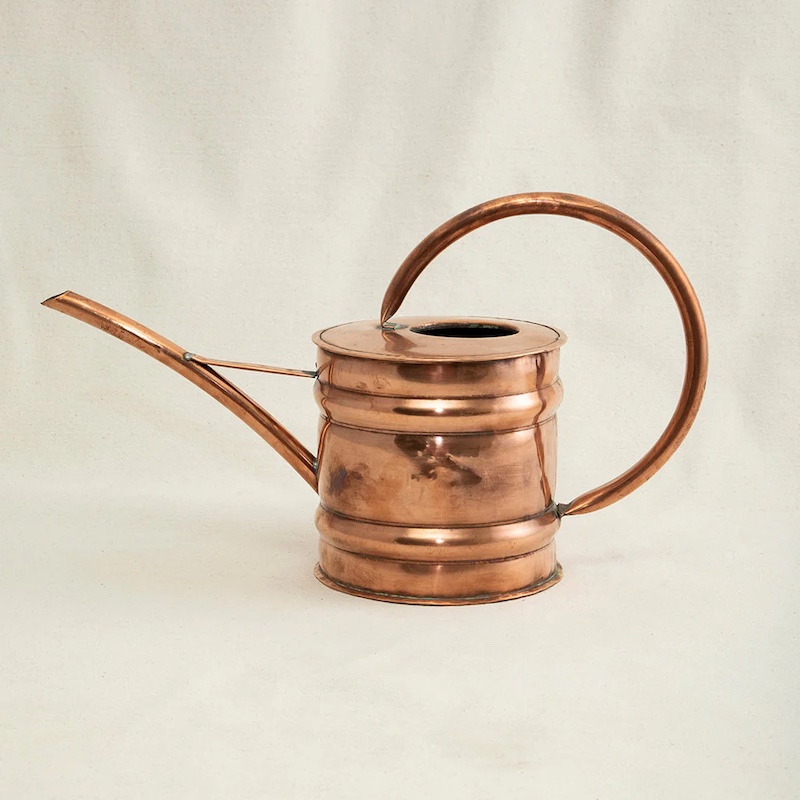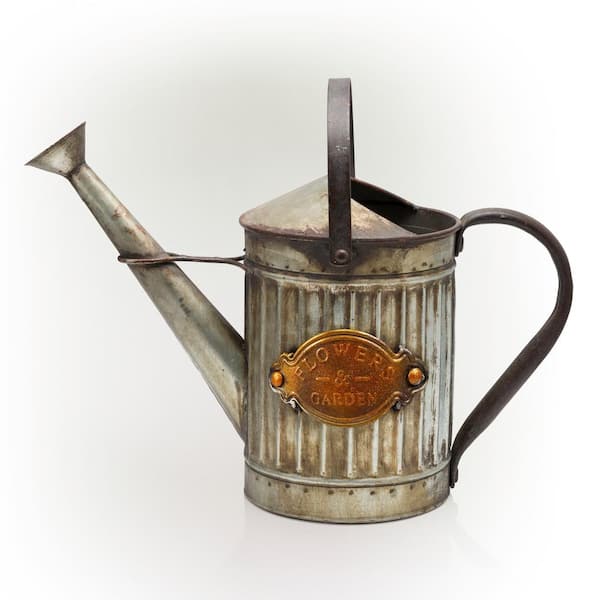
A Rewarding Hobby: Antique Watering Can Collectors Guide
Introduction to Collecting Antique Watering Cans
Collecting the antique watering can can be a rewarding hobby. It combines history, art, and gardening in a unique blend. If you’re new to this niche, it’s useful to understand its attraction. Antique watering cans are more than just old gardening tools. They are a window into the past and showcase craftsmanship from bygone eras.
New collectors should start by learning the basics. Know the different materials and designs that mark an item as an antique watering can. Some are made from metals like copper or galvanized iron. Others might feature intricate patterns or special markings.
It’s also crucial to be aware of the condition. Look for signs of wear and authenticity. This might include patinas, maker’s marks, or historical insignia. Remember, the condition can greatly affect the value of the watering can.
Connect with other enthusiasts to learn from their experiences. Join online forums, attend auctions, or visit flea markets. These are great places to gather valuable insights. Here, you can see a variety of antique watering cans up close.
Lastly, be patient and don’t rush your purchases. It’s better to build a small collection of valuable pieces than to have many of lesser quality. Enjoy the journey of finding each unique piece and adding it to your collection. Start exploring the world of antique watering cans and their rich history!
The History of Watering Cans and Their Evolution
The story of the watering can begins centuries ago. Early designs were simple and practical. They used materials easily found in nature like animal skins or hollowed-out gourds. As societies advanced, so did the tools they used. Metalworking skills brought us the first metal watering cans. They were durable and could last a lifetime. By the 17th century, watering cans were common in gardens across Europe. They often had a single handle and a spout. This design allowed gardeners to control the flow of water better.
The 19th century saw a boom in horticulture. Watering cans evolved to meet the needs of more serious gardeners. They began to feature a rose—a perforated nozzle. This created a gentle shower for delicate plants. Industrialization also played a role. It allowed for mass production of watering cans. Suddenly, they were not just for the wealthy. Everyone could own one. This era also introduced new shapes and decorative elements. Some watering cans from this period are now sought-after antiques.
Twentieth-century watering cans advanced with technology. Rust-resistant metals and new alloys emerged. These materials extended the lifespan and utility of the cans. The design became more refined too. Handles and spouts offered greater comfort and efficiency. Today, antique watering cans are a testament to these advances. Collectors appreciate both their form and function. They stand as a symbol of gardening’s rich history.
Identifying Antique Watering Cans: Materials and Markings
To start identifying antique watering cans, pay attention to materials and markings. Expert collectors know these can reveal a lot about a can’s age and origin.
First, examine the material. Antique watering cans come in various metals. Common ones include copper, brass, and galvanized iron. Their weight, color, and texture can signal their time period. For instance, heavy copper cans often hail from the 18th or 19th century.
Next, look for maker’s marks. These are signatures or symbols from the manufacturer and can be quite distinct. They sit on the bottom or side of the can. Authentic marks add to a can’s historical value.
You should also check for any unique features. This includes hand-crafted designs or special finishes such as a patina. A patina is a green or brown film on the surface of bronze or similar metals, produced by oxidation over time. It indicates the can has aged naturally and wasn’t recently made to look old.
Lastly, inspect for signs of original construction versus modern repairs. The method of joining pieces, like soldering, can tell you if the can is genuinely antique or if parts have been replaced. Look closely at seams and edges for signs of wear consistent with the can’s age.
Remember, identifying antique watering cans can be complex. Always gather as much information as possible. Cross-reference your findings with reputable guides and consult other enthusiasts when in doubt.
The Various Styles and Designs of Antique Watering Cans
Antique watering cans come in many styles and designs. Collectors often seek out pieces with unique shapes or features. Let’s explore some common types you might encounter.
- Long Spout Watering Cans: These have a slender spout that makes watering easy. They are great for reaching plants without causing damage.
- Round or Oval Bodies: Many antique cans showcase a round or oval body. This shape is classic and often associated with older models.
- Decorative Elements: Some cans feature ornate designs or embossed patterns. Details may include floral motifs or geometrical shapes.
- Rose Watering Cans: Equipped with a rose, or a perforated nozzle, these provide a gentle shower for plants. They became popular in the 19th century.
- Animal-Shaped Watering Cans: These whimsical cans take the form of animals. They add a playful touch to any collection.
- Wall-Mounted Watering Cans: Functional and decorative, these were hung on walls when not in use.
- Miniature Watering Cans: Small cans were not just for children. They also served to water indoor plants or as decorative pieces.
- Painted Watering Cans: Some antique cans boast painted surfaces. They can tell stories through their artwork.
Remember, the style and design help tell the age and origin story of an antique watering can. Look at the overall shape, handle design, and spout’s form. A diverse collection showcases a range of designs and the evolution of these charming relics.
Where to Find Antique Watering Cans: Tips and Tricks
Finding antique watering cans can be a delightful treasure hunt. Here are some tips and tricks to help you locate these historical pieces:
- Visit Local Antique Shops: Start close to home. Local antique shops often have a variety of watering cans. Inspect each one carefully for age and condition.
- Check Out Estate Sales: Estate sales can be gold mines for antique finds. They sometimes offer rare pieces at reasonable prices.
- Attend Garden and Antique Fairs: These fairs often feature vendors who specialize in garden antiques. They are a great place to find unique watering cans.
- Explore Online Auctions: Websites like eBay have a wide selection. Be sure to read the product descriptions and view all photos.
- Connect with Collectors Groups: Join forums or social media groups. Fellow collectors can offer advice and may even have cans for sale.
- Visit Flea Markets: Flea markets are known for unexpected treasures. Arrive early for the best selection.
- Check out Online Marketplaces: Websites like Etsy can connect you with sellers of antique goods from around the world. Always check seller reviews and ratings.
- Use Keyword Searches: When searching online, use keywords like ‘antique watering can’ to narrow your search.
Remember, when searching for antique watering cans, patience and persistence are key. With these tips, you’re well on your way to adding beautiful and historic pieces to your collection.
How to Determine the Value of Antique Watering Cans
Determining the value of an antique watering can involves several factors. Here is a simple guide to help you assess its worth:
- Check the Age: Older cans generally hold more value. Look for dating clues in their materials, design, and markings.
- Assess the Condition: Value increases for cans in good shape. Minor wear is acceptable but avoid cans with major damage.
- Note Rarity: Unique or scarce designs can be more expensive. Single-handle designs and hand-crafted details often indicate a rare piece.
- Research Maker’s Marks: Identify the manufacturer. Can with clear, recognizable marks may be more valuable.
- Consult Price Guides: Use guides or auction results to compare prices. These can indicate current market trends for various types of antique watering cans.
- Survey Demand: High demand can drive up prices. Check interest in similar cans among collectors and at antique shops.
- Examine Restorations: Original cans are usually worth more. Those with modern repairs or parts might be less valuable.
- Authenticity is Key: Ensure the watering can is authentic. Replicas or fakes are worth significantly less than real antiques.
Remember, while common watering cans might be moderately priced, rare and well-preserved examples could be considerably valuable. Take your time to research and understand what you have. Connect with experts if needed for a more accurate valuation.
Caring for and Preserving Your Antique Watering Can Collection
Caring for antique watering cans is key to maintaining their value and charm. Here are steps to follow for proper care and preservation:
- Handle with Care: Always use a gentle touch. Avoid rough handling that can dent or scratch the metal.
- Clean with Caution: Use a soft cloth to wipe away dust. For tougher dirt, use mild soap and water. Dry immediately to prevent rust.
- Avoid Harsh Chemicals: Never use abrasive cleaners. They can harm the can’s patina and reduce its value.
- Display Wisely: Keep cans out of direct sunlight. This prevents paint from fading. Also, avoid damp areas to stop rust or corrosion.
- Repair with Respect: If repair is needed, find an expert. It’s important to retain the can’s original features as much as possible.
- Regular Inspections: Check your cans often for any signs of damage. Early detection can prevent serious issues.
- Control the Environment: Maintain a stable climate. Extreme temperatures and humidity can damage antique metals.
- Document Your Collection: Keep records of each piece. Include photos, descriptions, and condition reports.
By following these tips, your antique watering cans can last for many more years. This will keep your collection both beautiful and valuable. Remember, every can tells a story. Preserve that story with care and attention.
Highlighting Unique and Rare Antique Watering Can Finds
Every collector dreams of stumbling upon that one unique or rare find. Antique watering cans are no exception. They often hide gems waiting to be discovered. Pay attention to the distinctive features that set them apart. Here are some key points to consider.
- Look for Uncommon Shapes: Unique forms can be quite valuable. They range from abstract figures to designs inspired by nature.
- Search for Signature Designs: Certain makers crafted signature styles. These can command higher prices due to their distinctiveness.
- Find Cans with Provenance: A watering can with a known history can be a real treasure. This might include items from famous gardens or ones owned by historical figures.
- Check for Limited Editions: Occasionally, manufacturers released limited runs. These often have serial numbers or special markings.
- Seek Out Decorative Features: Extra details like hand-painted designs or embossed images can signal a rare find.
- The Story Matters: Sometimes, it’s the story behind the can that drives its rarity. Cans with a documented past spark the imagination and the wallet.
- Regional Designs: Certain regions had specific styles or production techniques. These can be rare outside their area of origin.
- Condition Counts: Even rare cans need to be in good condition. Find ones that have been well-preserved for the best value.
Remember to use patience and do your homework. With some luck and diligent searching, you may add a singular and enchanting piece to your collection.

Antique Watering Can Collecting Guide: Era’s Culture & Technology
The History of Watering Cans
The history of the antique watering can is both rich and varied. These practical tools date back centuries. They have been pivotal for garden care across cultures. Originally, people used simple containers to carry water to plants. Over time, these evolved into more refined designs. The 17th century saw the rise of metal watering cans. They became artful and intricate with progression.
In the 1800s, watering cans spread widely due to the industrial revolution. Mass production made them household items. They came in various shapes and sizes, unique to different regions. The antique watering cans we see today are remnants of these times. They often reflect the era’s culture and technology.
Collectors value cans for their design, material, and markings. A can’s handle, spout shape, and decorations can indicate its age. Old cans might show craftsmanship now lost in modern times. Skilled artisans once hand-made these items. They used materials like brass, copper, and galvanized steel.
The antique watering can is not just a tool but a window into history. Its development mirrors changes in manufacturing, art, and gardening. For collectors, understanding the history is key. It helps identify authentic pieces and tells a story of past lives. Remember, each antique watering can has a tale to whisper. It’s an echo of hands that once toiled in gardens long before ours.
Identifying Antique Watering Cans
Identifying antique watering cans can be a fascinating journey into the past. Here are key points to help decipher their age and authenticity:
- Examine the Material: Antique watering cans were often made with materials like brass, copper, and galvanized steel. Look for signs of these materials to establish antiquity.
- Assess the Craftsmanship: Artisanal details, like hand-made features and intricate designs, suggest a can’s historical value. Machine-made details might indicate a more modern make.
- Check the Design: Pay attention to the can’s handle and spout shape. Unique or customary designs can signal the era it comes from.
- Search for Markings: Maker’s marks, stamps, or inscriptions are clues to identity and provenance. These marks were often unique to the creator or region.
- Consider the Patina: A genuine antique shows its age through patina – the natural wear and tarnishing over time. A lack of patina may require a closer examination.
- Consult Reference Guides: Utilize collector’s books and online resources to compare your finds. They can provide valuable information for identification.
By focusing on these aspects, collectors can often determine the age, origin, and sometimes even the story behind each antique watering can. Remember to handle these items delicately as they are not just collectibles but pieces of history.
Factors that Affect the Value of Antique Watering Cans
When adding antique watering cans to your collection, you want to ensure you’re making a valuable choice. Here are key factors that can affect their worth:
- Age and Rarity: Generally, the older and rarer a watering can, the more valuable it can be. Collectors often seek unique pieces with significant history.
- Condition: The overall state of the watering can is critical. Pieces with minimal wear, free of dents and rust, can demand a higher price.
- Originality: Cans that have maintained their original components are usually more valued than those that have been repaired or altered.
- Provenance: Knowing the history and previous ownership can raise a can’s value, especially if it has been owned by notable persons or comes from a famous collection.
- Aesthetic Appeal: Some collectors look for watering cans with artistic or aesthetic qualities, such as elaborate designs or historical styles that resonate with current trends.
- Maker’s Mark: Antique watering cans with a maker’s mark or identifiable branding can have an increased value due to their identified heritage and authenticity.
- Cultural Significance: Cans that symbolize a particular era or cultural movement are often more sought after than those without such context.
By considering these factors, collectors can determine which antique watering cans are likely to appreciate over time and contribute meaningful stories to their collections.
Where to Find Antique Watering Cans
Finding antique watering cans is an exciting hunt. Here are some top spots to search for these treasures:
- Antique Shops: These stores specialize in vintage items. They often have a selection of watering cans. Check local shops to find pieces with local history.
- Estate Sales: Estate sales can be a goldmine for antique collectors. They may uncover rare and well-maintained cans from old households.
- Auctions: Keep an eye on local and online auction houses. They sometimes list antique watering cans with detailed descriptions.
- Online Marketplaces: Websites like eBay and Etsy offer a wide range of antiques. Use filters to narrow down your search to watering cans.
- Flea Markets: Stroll through flea markets to spot unique finds. You might haggle down the price on a hidden gem.
- Collectibles Fairs: Fairs often attract many sellers. They bring various options and potential bargain deals.
- Specialist Forums and Groups: Connect with other collectors online. They may have leads on where to find these antiques or offer cans for sale.
- Antique Shows: Travel to larger antique shows. They bring together many vendors, increasing your chances to find a special can.
Remember to use your knowledge from the previous sections when hunting for antique watering cans. It helps verify authenticity and value.
The Dos and Don’ts of Buying Antique Watering Cans
When you’re in the market for an antique watering can, it’s easy to get swept up in the excitement. However, there are several dos and don’ts you should keep in mind to ensure you make a savvy purchase.
- Do Your Research: Gather as much knowledge as possible about antique watering cans. Understanding their history, styles, and materials can help you make informed decisions.
- Do Inspect for Authenticity: Always check for signs of authenticity, such as material, craftsmanship, and markings. Be thorough in your examination.
- Do Set a Budget: Know what you’re willing to spend and stick to it. Antique watering cans can range greatly in price.
- Do Ask Questions: When possible, speak with the seller. Ask about the can’s history, condition, and any restorations.
- Don’t Rush to Buy: Take your time. A hasty decision can lead to buyers’ remorse, especially if you later discover issues with the can.
- Don’t Ignore Flaws: While patina adds character, significant damage may affect the value. Understand the difference between acceptable wear and severe damage.
- Don’t Overlook Provenance: A watering can with a well-documented history may be more valuable. Try to obtain this information when available.
- Don’t Forget about Size and Practicality: Consider how the can will fit into your collection. Ensure you have the space to properly display or store it.
By following these dos and don’ts, you can confidently add to your collection. You’ll find joy in each antique watering can, knowing you’ve made a thoughtful and educated choice.
How to Care for Your Antique Watering Can Collection
Caring for your antique watering can collection is essential to preserve its value and beauty. Here are straightforward tips to maintain these historical pieces:
- Handle with Care: Always use both hands when handling. These cans are often fragile due to their age.
- Clean Gently: Use a soft cloth to dust. For deeper cleaning, use a mild soap and water solution. Rinse and dry immediately.
- Avoid Abrasive Materials: Never use harsh chemicals or rough brushes. These can damage the material and patina.
- Store Properly: Keep cans in a dry, climate-controlled environment. Moisture and extreme temperatures can cause harm.
- Minimize Sunlight: Direct sunlight can fade and weaken metal over time. Show your collection in a well-lit but shaded spot.
- Regular Inspections: Check your cans regularly for signs of wear or damage. Early detection can prevent further decay.
- Professional Restoration: If restoration is necessary, enlist a professional. They know how to preserve the can’s historical integrity.
By following these steps, your antique watering can collection will continue to reflect its rich history. Remember, each piece represents a story from the past and deserves your careful attention.
Displaying Your Antique Watering Can Collection
Once you’ve gathered your treasured antique watering cans, it’s time to display them proudly. The way you showcase your collection can speak volumes about its importance to you. Here are tips for creating an attractive and respectful display:
- Choose the Right Space: Pick a spot that doesn’t get too much sunlight to avoid fading. Ensure the area is dry and stable.
- Display with Balance: Arrange your watering cans by size or period to create visual harmony. Put larger cans at the back and smaller ones in front.
- Use Stands or Mounts: Elevate your rarer cans on stands or secure mounts. This not only adds dimension but also protects them from being knocked over.
- Add Information Cards: Consider placing cards next to each can. Include the era, origin, and any unique story it might have.
- Rotate Your Collection: Keep your display fresh by switching out cans occasionally. This also prevents long-term exposure to any damaging conditions.
- Group by Theme: If you have multiple cans from a particular era or style, group them together. This creates a focused narrative for viewers.
A thoughtfully curated display allows you to share your passion for antique watering cans with others. It transforms your collection into an educational and visually engaging experience. Take care to place each can where it is safe, seen, and celebrated.
Antique Watering Can Replicas vs. Originals
When you explore the market for antique watering cans, you’ll encounter both originals and replicas. Knowing the difference is crucial as it impacts both value and satisfaction. Here’s what to keep in mind:
- Look for Age Signs: Originals have a history that replicas lack. Seek signs of aging like patina, wear, and natural tarnishing.
- Check the Craftsmanship: Originals often show handmade details. Replicas may have uniformity that hints at modern mass production.
- Evaluate Materials: True antiques are from brass, copper, or galvanized steel. Replicas might use less authentic or cheaper materials.
- Examine Markings: Genuine antiques often bear maker’s marks. Replicas may skip this detail or use markings that seem off.
- Assess the Price: If the deal seems too good, think twice. Originals usually cost more due to their historical value.
- Research Provenance: Ask for the history of the can. Originals often have stories attached, while replicas do not.
- Trust Your Instincts: If something feels not quite right, it may be a replica. Use your knowledge of antiques to guide you.
By being vigilant, you can differentiate between a valuable original and a less valuable replica. This knowledge ensures that you add pieces of true worth to your antique watering can collection.



